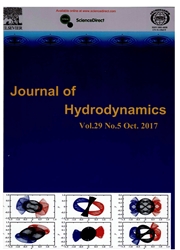

 中文摘要:
中文摘要:
To enhance the efficiency of a pathogen forecasting model in the beach areas of southern Lake Michigan and to reduce the computation time, the near-shore current is approximated as a channelized flow parallel to the shorelines in clockwise or anti-clockwise direction within the accuracy tolerance range. A channelized model with a curvilinear boundary can significantly reduce the computation effort, and at the same time achieve a good agreement between the predicted and measured water surface elevations, currents, and water temperatures. The sensitivity analysis results show that the suitable channel width for the near-shore region of southern Lake Michigan should be no less than 10 km. The modeling results of the water temperature are much less sensitive to the channel width than those of the current velocity and the water surface elevation. The modeling results also show a close correlation between the speeds of the wind and the near-shore current. The current may fully respond the wind stress with a time lag of several hours. The correlation may provide an approximate estimation of the lake circulation under some wind conditions for a practical forecasting purpose. More complex wind-current relationships need to be described with a more sophisticated hydrodynamic model. This verified model can be used for the pathogen forecasting in the near-shore regions of southern Lake Michigan in the future.
 英文摘要:
英文摘要:
To enhance the efficiency of a pathogen forecasting model in the beach areas of southern Lake Michigan and to reduce the computation time, the near-shore current is approximated as a channelized flow parallel to the shorelines in clockwise or anti-clock- wise direction within the accuracy tolerance range. A channelized model with a curvilinear boundary can significantly reduce the computation effort, and at the same time achieve a good agreement between the predicted and measured water surface elevations, currents, and water temperatures. The sensitivity analysis results show that the suitable channel width for the near-shore region of southern Lake Michigan should be no less than 10 kin. The modeling results of the water temperature are much less sensitive to the channel width than those of the current velocity and the water surface elevation. The modeling results also show a close correlation between the speeds of the wind and the near-shore current. The current may fully respond the wind stress with a time lag of several hours. The correlation may provide an approximate estimation of the lake circulation under some wind conditions for a practical fore- casting purpose. More complex wind-current relationships need to be described with a more sophisticated hydrodynamic model. This verified model can be used for the pathogen forecasting in the near-shore regions of southern Lake Michigan in the future.
 同期刊论文项目
同期刊论文项目
 同项目期刊论文
同项目期刊论文
 期刊信息
期刊信息
